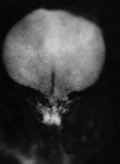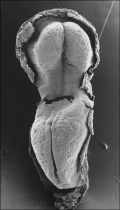Week 3: Difference between revisions
| Line 68: | Line 68: | ||
|- | |- | ||
|} | |} | ||
==Week 2 Abnormalities== | |||
===Monoygotic Twinning=== | |||
Monozygotic twins (identical) produced from a single [[F#fertilization|fertilization]] event (one fertilised egg and a single spermatazoa, form a single zygote), these twins therefore share the same genetic makeup. Occurs in approximately 3-5 per 1000 pregnancies, more commonly with aged mothers. The later the twinning event, the less common are initially separate placental membranes and finally resulting in conjoined twins. | |||
{| class="prettytable" 100% | |||
| width=10% | '''Week''' | |||
| | |||
| colspan="7" | Week 1 | |||
| colspan="7" | Week 2 | |||
|-bgcolor="lightsteelblue" | |||
| '''Day''' | |||
| width=5% | 0 | |||
| width=5% | 1 | |||
| width=5% | 2 | |||
| width=5% | 3 | |||
| width=5% | 4 | |||
| width=5% | 5 | |||
| width=5% | 6 | |||
| width=5% | 7 | |||
| width=5% | 8 | |||
| width=5% | 9 | |||
| width=5% | 10 | |||
| width=5% | 11 | |||
| width=5% | 12 | |||
| width=5% | 13 | |||
| width=5% | 14 | |||
|- | |||
| '''Cell Number''' | |||
| 1 | |||
| 1 | |||
| 2 | |||
| 16 | |||
| 32 | |||
| 128 | |||
| | |||
| | |||
| | |||
| bilaminar | |||
| | |||
| | |||
| | |||
| | |||
| | |||
|- | |||
| '''Event''' | |||
| Ovulation | |||
| fertilization | |||
| First cell division | |||
| Morula | |||
| Early blastocyst | |||
| Late blastocyst | |||
Hatching | |||
| Implantation starts | |||
| | |||
| | |||
| X inactivation | |||
| | |||
| | |||
| | |||
| | |||
| | |||
|- | |||
| | |||
| [[File:Follicle 001 icon.jpg|50px]] | |||
| [[File:Early_zygote.jpg|50px]] | |||
| [[File:Human embryo day 2.jpg|50px]] | |||
| [[File:Human embryo day 3.jpg|50px]] | |||
| [[File:Human embryo day 5.jpg|50px]] | |||
| [[File:CSt3.jpg|50px]] | |||
| [[File:Week2_001 icon.jpg|50px]] | |||
| | |||
| | |||
| | |||
| | |||
| | |||
| | |||
| | |||
| | |||
|-bgcolor="lightsteelblue" | |||
| '''Monoygotic''' | |||
'''Twin Type''' | |||
| | |||
| colspan="3" | Diamniotic | |||
Dichorionic | |||
| colspan="3" | Diamniotic | |||
Monochorionic | |||
| colspan="3" | Monoamniotic | |||
Monochorionic | |||
| colspan="5" | Conjoined | |||
|- | |||
| | |||
| | |||
| | |||
| | |||
| | |||
| | |||
| | |||
| | |||
| | |||
| | |||
| | |||
| | |||
| | |||
| | |||
| | |||
| | |||
|} | |||
Table based upon: Twinning. Hall JG. Lancet. 2003 Aug 30;362(9385):735-43. Review. [http://www.ncbi.nlm.nih.gov/pubmed/12957099 PMID: 12957099] | |||
{{Template:Week}} | |||
{{Template:Carnegie_stages}} | |||
{{Template:Glossary}} | |||
{{Template:Footer}} | |||
[[Category:Human Embryo]] [[Category:Carnegie Stage]] [[Category:Week 1]] [[Category:Fertilization]] | |||
{{Template:Week}} | {{Template:Week}} | ||
Revision as of 09:30, 15 June 2010
Introduction
Key events of human development during the third week (week 3) following fertilization or Clinical week 5 (LMP). Note that during this time the conceptus cells not contributing to the embryo are contributing to placental membranes and the early placenta.
During the third week of development conceptus implantion in the uterus wall is complete and trophoblast cells continue to invade uterine wall in the process of early placentation (villi formation). Within the conceptus, gastrulation converts the bilaminar embryo into the trilaminar embryo (ectoderm, mesoderm, endoderm). Morphological changes include an epithelial to mesenchymal cell transition and folding of the the embryonic disc. Carnegie stages 7 to 9 covers this period of human embryo development.
| Event | ||
| Stage 7 | Primitive node (Hensen's node, primitive knot) The small circular region located at the cranial end of the primitive streak, where gastrulation occurs, and is a controller of this process. The second role is to act as an initial generator of the left-right (L-R) body axis. | |
| Stage 8 | Neural neurogenesis, neural groove and folds are first seen | |
| Stage 9 |  Musculoskeletal somitogenesis, first somites form and continue to be added in sequence caudally Musculoskeletal somitogenesis, first somites form and continue to be added in sequence caudally
Neural the three main divisions of the brain, which are not cerebral vesicles, can be distinguished while the neural groove is still completely open Neural Crest mesencephalic neural crest is visible PMID: 17848161 | |
| Heart cardiogenesis, week 3 begins as paired heart tubes. |
Week 2 and 3 Movies
| Implantation | Mesoderm | Chorionic Cavity | Amniotic Cavity | Week 3 |
Week 2 Abnormalities
Monoygotic Twinning
Monozygotic twins (identical) produced from a single fertilization event (one fertilised egg and a single spermatazoa, form a single zygote), these twins therefore share the same genetic makeup. Occurs in approximately 3-5 per 1000 pregnancies, more commonly with aged mothers. The later the twinning event, the less common are initially separate placental membranes and finally resulting in conjoined twins.
Table based upon: Twinning. Hall JG. Lancet. 2003 Aug 30;362(9385):735-43. Review. PMID: 12957099
Embryo Week: Week 1 | Week 2 | Week 3 | Week 4 | Week 5 | Week 6 | Week 7 | Week 8 | Week 9
- Carnegie Stages: 1 | 2 | 3 | 4 | 5 | 6 | 7 | 8 | 9 | 10 | 11 | 12 | 13 | 14 | 15 | 16 | 17 | 18 | 19 | 20 | 21 | 22 | 23 | About Stages | Timeline
Glossary Links
- Glossary: A | B | C | D | E | F | G | H | I | J | K | L | M | N | O | P | Q | R | S | T | U | V | W | X | Y | Z | Numbers | Symbols | Term Link
Cite this page: Hill, M.A. (2024, April 26) Embryology Week 3. Retrieved from https://embryology.med.unsw.edu.au/embryology/index.php/Week_3
- © Dr Mark Hill 2024, UNSW Embryology ISBN: 978 0 7334 2609 4 - UNSW CRICOS Provider Code No. 00098G
Embryo Week: Week 1 | Week 2 | Week 3 | Week 4 | Week 5 | Week 6 | Week 7 | Week 8 | Week 9
- Carnegie Stages: 1 | 2 | 3 | 4 | 5 | 6 | 7 | 8 | 9 | 10 | 11 | 12 | 13 | 14 | 15 | 16 | 17 | 18 | 19 | 20 | 21 | 22 | 23 | About Stages | Timeline
Glossary Links
- Glossary: A | B | C | D | E | F | G | H | I | J | K | L | M | N | O | P | Q | R | S | T | U | V | W | X | Y | Z | Numbers | Symbols | Term Link
Cite this page: Hill, M.A. (2024, April 26) Embryology Week 3. Retrieved from https://embryology.med.unsw.edu.au/embryology/index.php/Week_3
- © Dr Mark Hill 2024, UNSW Embryology ISBN: 978 0 7334 2609 4 - UNSW CRICOS Provider Code No. 00098G





